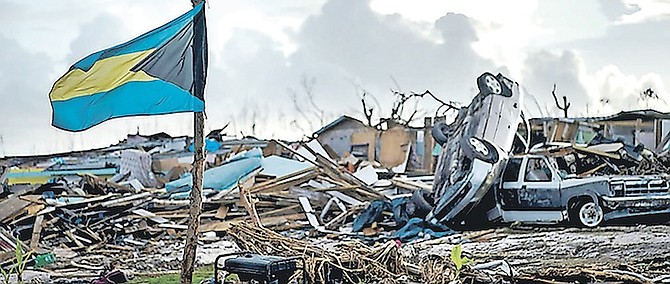“I have no choice but to keep on repeating it. What will it take for you to listen to us? Our islands are slowly being eaten by the sea, one by one. If we do not reverse this trend, the Maldives will cease to exist by the end of the century.”
– President Ibrahim Mohamed Solih of the Maldives
IN the closing days of August 2030, the ninth month of the year, a peak period for Atlantic hurricanes, the country nervously watched a gathering storm. It began as an unreported weather phenomenon off West Africa, travelling westerly and eventually funnelled toward The Bahamas as a tropical storm.
Many years before 2030, unimaginable storms were now more common in the Caribbean, a hotter atmosphere breeding a wetter atmosphere.
A National Geographic story instructed: “Warm ocean water is fuel to a hurricane, powering it like an engine.
The warmer the water, the more the engine revs, growing faster, larger, and capable of dumping more water.” Climate change boils the water needed for stronger brews of storms.
Travelling north of Hispaniola and heading northwest, the 2030 storm headed toward Mayaguana, trekking through the archipelago, venturing toward the Central Bahamas, rapidly churning into a Category 5 hurricane in ever warming tropical Bahamian waters.
The usual superstition, debate about where the storm would make landfall, religious reckoning and bargaining, and conspiratorial thinking were pervasive. There was uncertainty as to where the storm and its well-formed eyewall – “where the most damaging winds and intense rainfall is found” – would cause the most damage.
Most people in the country were largely disconnected from the reality and threats of climate change, indifferent, mostly unaware. Years earlier, the decision to ban single use plastics blew up into a silly public brouhaha, with quite a number complaining that they had to pay 25 cents for a plastic bag.
SPEECHES
Despite the ritual speeches with rhetoric of an “existential crisis”, and attendance at international conferences, neither major political party had significantly built up the resilience and adaptation measures required throughout the archipelago.
Most political leaders had failed to press the urgency of the climate emergency to Bahamians.
They failed to fully appreciate the warning of the United Nation’s Development Programme (UNDP) for The Bahamas:
“Costs associated with planned adaptation will be high but the cost of not acting will be measured directly in loss of life, loss of competitiveness in the tourism sector and often at the expense of the environment.”
Residents of New Providence were strongly advised to make preparations for the potential impact of the Category 5 storm, and if necessary, move to shelters. Because the island had not received a direct hit in decades, many thought they would once again avoid the brunt of the disaster.
Most made some preparation. But many refused to evacuate to shelters. Many of them would be found dead after the hurricane. Over a thousand or more flew out of the country.
The hurricane first made landfall on New Providence in the surrounds of Adelaide Village, a marshland on the southwestern coast, established in the early 1830s for freed slaves.
Adelaide was obliterated, eaten by the sea surge and drowned by the relentless downpour. No structures were left intact. Most of those who refused to evacuate died.
The slow-moving monster storm took its time, hovering, creeping over New Providence and Paradise Island, unleashing a tyranny of wind and water.
Like a weapon unleashed from the sky, the blasts of the hurricane moved outward, affecting the entire landmass of New Providence.
The topography of the island is made up of a higher central ridge, including Mount Fitzwilliam. With little other elevation, New Providence is mostly flat, with some hilltops, a number of which have been excavated.
Moving south and Over-the-Hill, there are extensive low-lying areas which form a bowl in which water easily collects, with limited drainage, despite various infrastructural upgrades.
STALLED
Areas like Pinewood Gardens, always at risk from heavy rain, were inundated with water reaching rooftops. Quite a number, including children, drowning from the mixture of sea surge and rainfall as the hurricane stalled over New Providence for deadly hours.
When the 2030 hurricane struck, most of Over-the-Hill and many other communities could now only be accessed by jet skis and boats, the high waters concealing many dangers, including contamination and the risk of various diseases.
The death toll in these communities was numbering in the many hundreds. Like similar disasters, there would never be a full accounting of the dead, including the number of undocumented migrants killed.
The hurricane that punished New Providence proved as powerful as Hurricane Dorian, which devastated much of Abaco, the Abaco Cays and parts of Grand Bahama 11 years earlier.
The stark differences this time were the population density of New Providence and the vastly larger economic and public infrastructure.
This time, the central government, which coordinated the Dorian response, mostly collapsed, with few assets and resources left to command, including public health facilities, medicine and adequate health personnel.
Hours before the New Providence hurricane struck, the Cabinet agreed that the Governor General, the Chief Justice and half the cabinet should be evacuated to Grand Bahama.
Some contingencies were in place, with many of these proving inconsequential as the security infrastructure of the Royal Bahamas Police Force and the Royal Bahamas Defence Force, as well as the central administration, including the Office of the Prime Minister, the Cabinet Office and many government ministries either destroyed or unusable.
With most of the overhead electrical grid and telecommunications infrastructure destroyed, food and water scarce, and other basics of life unavailable, New Providence was now in need of the mercy of foreign governments and international agencies.
Widespread panic and looting ensued. Many residents, including those with generators, were banding together and barricading themselves in their homes. There was a quick and brutal uptick in gun crimes and violence.
The capacity of government to respond was now minimal. Desperate for help, even those who criticized the then government’s assistance to Dominica in 2017, were begging for help from Caricom, the United States and the world.
The Cabinet quickly agreed to ask the United States and Caricom to send in 2,500 armed military and other security personnel, and assets to restore basic law and order.
The Government had nearly no capacity left to administer the nation-state. Nighttime curfews and other emergency regulations were instituted indefinitely.
Cruise ships were brought in as offices and facilities for the civil service, security agencies, international aid groups and others. A decision had to be made as to whether to relocate the capital and the heads of the government bureaucracy to Freeport.
The Bahamas began negotiations with other countries to accept students, older citizens and others with health care needs, and climate refugees.
Internal refugees in the tens of thousands moved to various Family Islands to stay with family.
DISASTERS
According to the United Nation’s Secretary General António Guterres, approximately four billion people have been affected by climate-related disasters in the last decade.
Most Bahamians, especially the residents of New Providence, because they did not personally experience the effects of Dorian, remain largely unconcerned about or do not understand the degree and danger of climate change.
Referring to the storm which devastated Dominica in 2017, National Geographic commented: “What unites the country, however, is a sense of patriotism forged from shared trauma. Embroidered on t-shirts and painted on buildings is the mantra ‘Dominica strong.’”
A resident declared: “It’s how every citizen seems to describe their country – strong in the wake of disaster. People are taking things more seriously. They’re building much stronger.” Just about every Dominican was affected by Maria.
Over a period of four hours in 2017, Hurricane Irma destroyed 90 percent of the country’s infrastructure and its economy was crippled. Dominica lost 226 percent of its GDP.
In The Bahamas we do not have a sense of patriotism forged from the shared trauma of a major climate event.
Humans move toward conversion or tend to change because of lived experience.
Our sense of national identity is often sentimental and nostalgic. Residents of New Providence may boast of Family Island ties or enjoy a homecoming weekend. But most are oblivious to the circumstances and needs of other islands.
Days after the devastation of Dorian, some public sector union leaders were calling for increments as the country faced “estimated damages and losses… [of] $3.4 billion (IDB, 2019), a number equivalent to a quarter of the country’s GDP.” It was an act of disgraceful selfishness and self-absorption at a grave hour.
At the Conference of Parties (COP) 26 summit in Glasgow, Barbados Prime Minister Mia Motley again lent her powerful and passionate moral and intellectual voice on behalf of Caricom and the smaller nations of the world:
“It’s like me throwing garbage into your yard and telling you to pay to clean it up – even if it means you can’t pay your mortgage, you can’t buy food. You can’t do anything because you have to spend all your money on the garbage I threw into your yard.”
The head of the United Nation’s Environmental Programme noted disappointingly that many of the pledges made at the summit were akin to: “An elephant giving birth to a mouse.”
Countries in the Pacific, like Fiji, Kiribati, Tonga, the Maldives, Tuvalu, the Federated States of Micronesia and others recognize that while discussions and pledges on limiting carbon emissions are critical, much of this debate is in some ways irrelevant to countries already being eaten by the sea, island by island, country by country.
We cannot wait on the rich countries of the world to do what is just and right. We will have to work tirelessly and collectively to get even minimal aid for resilience and adaptation.
And, we will have to work quickly as the impending and gathering storms are on the horizon.
Academics, commentators, businesses and the media in The Bahamas have a tremendous responsibility to educate and inform Bahamians about climate change, to press governments for clear strategies, and to push citizens toward greater personal and civic responsibility.
As one commentator observed, getting citizens to understand the need for action and change, is also a cognitive and emotional battle.
Our collective indifference, ignorance and obliviousness will end, either through education and greater consciousness or through the wrathful instruction of a monster hurricane to the residents of our most populous island.
This 700th column by this writer is dedicated to a beloved and dear friend, a great mentor, and three respective editors. Thank you to the many readers, and those who assisted through critical insight, support and ideas for improvement and growth.






Comments
Use the comment form below to begin a discussion about this content.
Sign in to comment
Or login with:
OpenID